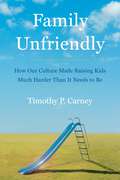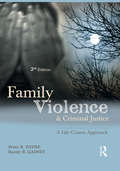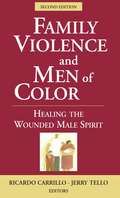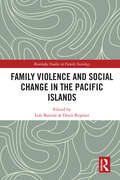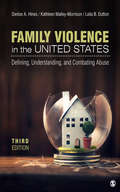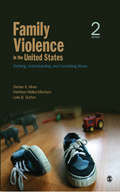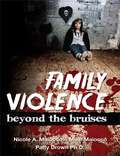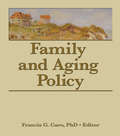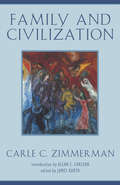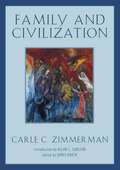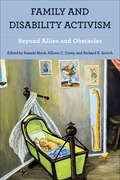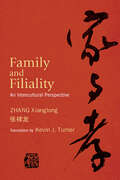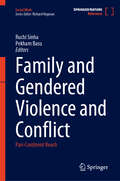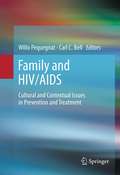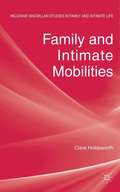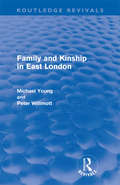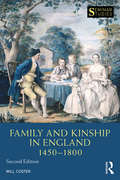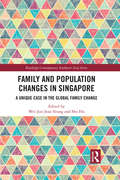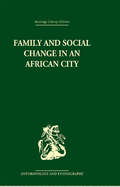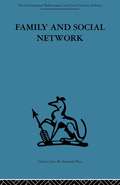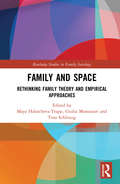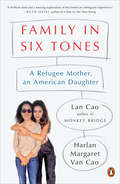- Table View
- List View
Family Unfriendly: How Our Culture Made Raising Kids Much Harder Than It Needs to Be
by Timothy P CarneyThe bestselling author of Alienated America traveled the country asking families and experts the same two questions: Why is parenting so hard now? And why are the results so bad?Our culture tells parents there's one best way to raise kids: enroll them in a dozen activities, protect them from trauma, and get them into the most expensive college you can. If you can't do that, don't bother.How is that going? Record rates of anxiety, depression, medication, debts, loneliness and more. In Family Unfriendly, bestselling author and Washington Examiner columnist Timothy P. Carney says it's time to end this failed experiment in overparenting.Have more kids, have more fun, cancel the travel soccer games, let your kids wander off, and give them deeper sources of meaning than material success. This is an old-fashioned view, but every day the evidence validates it. Drawing on rigorous research—both as a reporter and as a dad of six—Carney demonstrates why modern parenting is so misguided. The high standards set for modern American parenting are unrealistic and setting parents—and our kids—up to fail.Researched over three years and written in between rec baseball games and church picnics where nobody was watching the kids, Family Unfriendly is deeply wise, energetically told, and destined to be the most consequential book about parenting in years.
Family Violence From a Global Perspective: A Strengths-Based Approach
by Sylvia M. Asay John DeFrain Marcee Metzger Bob MoyerThis one-of-a-kind edited collection draws on the expertise of authors from 16 countries representing 17 cultures to tell the story of domestic violence in their respective parts of the world. The book incorporates a strengths-based approach, including individual, relationship, community, and societal strengths. The collection draws on multiple perspectives (academics, counselors, organizers, activists, and victims) to determine strengths and analyze how they can translate into greater safety for victims, increased accountability of perpetrators, and improved policy formation and research. Each chapter focuses on the lived experiences of victims of intimate partner violence, child abuse, or elder abuse and includes information about the abuser, the family, the community, and the culture.
Family Violence and Criminal Justice: A Life-Course Approach
by Brian P. Payne Randy R. GaineyThe historical context of family violence is explored, as well as the various forms of violence, their prevalence in specific stages of life, and responses to it made by the criminal justice system and other agencies. The linkage among child abuse, partner violence and elder abuse is scrutinized, and the usefulness of the life-course approach is couched in terms of its potential effect on policy implications; research methods that recognize the importance of life stages, trajectories, and transitions; and crime causation theories that can be enhanced by it.
Family Violence and Men of Color: Healing the Wounded Male Spirit (Second Edition)
by Ricardo Carrillo Jerry Tello"Family violence is an international epidemic that knows no cultural boundaries, but for years research has overlooked the historical, political and cultural factors that often lead men toward violent behavior. The first edition of Family Violence and Men of Color broke new ground by closely examining the relationship between race and family violence. This revised edition offers an even broader, cross-cultural analysis of male violence and more specialized treatment methods and approaches.
Family Violence and Social Change in the Pacific Islands (Routledge Studies in Family Sociology)
by Denis Regnier Loïs BastideThe Pacific Islands have some of the highest rates of family violence in the world. Addressing the contemporary mutations of Pacific Island families and the shifting understandings of violence in the context of rapid social change, this book investigates the conflict dynamics generated by these transformations. The contributors draw from detailed case studies in a range of Pacific territories to examine family violence in relation to the social, economic and political situation of native populations as well as individual, collective and institutional responses to the development of violence within and upon the family. They focus on vernacular understandings, conflicting social norms, the emergence of different types of violent patterns, the impact of violence on individuals and communities, and local attempts at mitigating or combating it. Combining ethnographic expertise with engaged scholarship, this volume offers a vivid account of ongoing social change in Pacific Island societies and a crucial contribution to the understanding of family violence as a social process, cultural construct, and political issue. This book will appeal to scholars with interests in the sociology of violence and the family, Pacific studies, development studies, and the social and cultural anthropology of Oceania.
Family Violence in the United States: Defining, Understanding, and Combating Abuse
by Leila B. Dutton Denise A. Hines Kathleen M. Malley-MorrisonFamily Violence in the United States takes an ecological approach to examining violence and abuse within the context of families. Easy-to-read chapters are organized by exploring the "Scope of the Problem", definitions of key terminology, predictors, and consequences of different forms of maltreatment. Attention is paid to larger social systems that can contribute to abuse, as well as community, relationship, and individual predictors of both perpetration and victimization. Additionally, there is an emphasis on both prevention and intervention of family violence at various levels of the ecological model. Authors Denise A. Hines, Kathleen Malley-Morrison, and Leila B. Dutton help students explore what family violence is and the reasons why it happens. Their approach covers contemporary and controversial topics across the lifespan, including maltreatment of male partners by women, of parents, within sexual minority relationships, and on college campuses. This 3rd edition is filled with chapter-opening cases to prompt discussion within the classroom as well as considerations of context and application in the larger community. Rich in scholarly references and case materials, it is suitable for advanced undergraduates, graduate students, and professionals alike.
Family Violence in the United States: Defining, Understanding, and Combating Abuse
by Leila B. Dutton Denise A. Hines Kathleen M. Malley-MorrisonFamily Violence in the United States takes an ecological approach to examining violence and abuse within the context of families. Easy-to-read chapters are organized by exploring the "Scope of the Problem", definitions of key terminology, predictors, and consequences of different forms of maltreatment. Attention is paid to larger social systems that can contribute to abuse, as well as community, relationship, and individual predictors of both perpetration and victimization. Additionally, there is an emphasis on both prevention and intervention of family violence at various levels of the ecological model. Authors Denise A. Hines, Kathleen Malley-Morrison, and Leila B. Dutton help students explore what family violence is and the reasons why it happens. Their approach covers contemporary and controversial topics across the lifespan, including maltreatment of male partners by women, of parents, within sexual minority relationships, and on college campuses. This 3rd edition is filled with chapter-opening cases to prompt discussion within the classroom as well as considerations of context and application in the larger community. Rich in scholarly references and case materials, it is suitable for advanced undergraduates, graduate students, and professionals alike.
Family Violence in the United States: Defining, Understanding, and Combating Abuse
by Dr Denise A. Hines Dr Kathleen M. Malley-Morrison Leila B. DuttonRich in scholarly references and case materials, Family Violence in the United States: Defining, Understanding, and Combating Abuse, Second Edition by Denise A. Hines, Kathleen Malley-Morrison, and Leila B. Dutton is a thought-provoking book that encourages students to question assumptions, evaluate information, formulate hypotheses, and design solutions to problems of family violence in the United States.
Family Violence: Beyond the Bruises
by Mike Maiocco Nicole MaioccoFamily violence is an epidemic plaguing our society and has been found to be the underlying cause of most crimes committed in America. Now more than ever, professionals must have a deeper understanding of this complex and harsh reality and become equipped to provide help and direction to those left in its wake. The psychological dynamics of family violence, laws and legal documents, investigation of the crime scene, and understanding the cycle of violence are each thoroughly outlined. Statistics, terminology, vital resources, and even types of injuries are just some of the covered topics. QR codes provide a unique perspective as the material "comes to life. "
Family and Aging Policy
by Francis G. CaroLearn how public policies can help families provide the care their elderly relatives needFamily and Aging Policy examines how public initiatives to assist the elderly in the United States, Canada, Singapore, Denmark, and Sweden can impact families who provide them with long-term care. For the majority of older people, the aging experience involves their families directly and indirectly, affecting income security, housing, and health care. This unique book addresses the aging issues that matter most to families struggling to deal with the demands of care giving and provides answers on how the public sector can help.As the traditional nuclear family becomes a memory and the notion of extended family disappears, the need for public interventions to help the elderly increases. A significant number of people grow old without families they can depend on. Others have families who want to help, but lack the financial means or the housing needed to provide care. Family and Aging Policy offers options on how families and formal services can share responsibilities, including how families can juggle jobs and care giving, the effects of the Family and Medical Leave Act, consumer-directed service options, community-based care programs, accessory dwelling units and zoning ordinances, and provisions for caregiver support in each of the 50 United States and the District of Columbia.Family and Aging Policy examines: extensive welfare programs in Sweden publicly funded home care programs in Denmark family-oriented social policies in Singapore shared responsibilities of families and formal services in Canada the Administration on Aging&’s National Family Caregiver Support program in the United States California Caregiver Resource Centers and much more!Family and Aging Policy is an invaluable tool for researchers and policy analysts working in family policy issues and as an essential supplemental text for course work in gerontology, sociology, family relations, and social work.
Family and Civilization
by Carle C. ZimmermanFamily and Civilization is the magnum opus of Carle Zimmerman, a distinguished sociologist who taught for many years at Harvard University. In this unjustly forgotten work Zimmerman demonstrates the close and causal connections between the rise and fall of different types of families and the rise and fall of civilizations, particularly ancient Greece and Rome, medieval and modern Europe, and the United States. Zimmerman traces the evolution of family structure from tribes and clans to extended and large nuclear families to the small nuclear families and broken families of today. And he shows the consequences of each structure for the bearing and rearing of children; for religion, law, and everyday life; and for the fate of civilization itself. Originally published in 1947, this compelling analysis predicted many of today's cultural and social controversies and trends, including youth violence and depression, abortion and homosexuality, the demographic collapse of Europe and of the West more generally, and the displacement of peoples. This new edition, part of ISI Books' Background series, has been edited and abridged by cultural commentator James Kurth of Swarthmore College and includes essays on the text by Kurth, Allan Carlson, and Bryce Christensen.
Family and Civilization
by Carle C. ZimmermanIn Family and Civilization, the distinguished Harvard sociologist Carle Zimmerman demonstrates the close and causal connections between the rise and fall of different types of families and the rise and fall of civilizations, particularly ancient Greece and Rome, medieval and modern Europe, and the United States. Zimmerman traces the evolution of family structure from tribes and clans to extended and large nuclear families to the smaller, often broken families of today. And he shows the consequences of each structure for bearing and rearing of children, for religion, law, and everyday life, and for the fate of civilization itself. Originally published in 1947, this compelling analysis predicted many of today's controversies and trends concerning youth violence and depression, abortion, and homosexuality, the demographic collapse of the West, and the displacement of peoples. This new edition has been edited and abridged by James Kurth of Swarthmore College. It includes essays on the text by Kurth and Bryce Christensen and an introduction by Allan C. Carlson.
Family and Class in a London Suburb (Routledge Library Editions: Family)
by Michael Young Peter WillmottOriginally published in 1960, the authors of Family and Kinship in East London then made an intensive study of a middle-class dormitory suburb. Here families were more often on their own than in the East End, but, despite the differences between the districts, there were some similarities. The bond between mother and married daughter was almost as strong in the suburb as in the city. Most old people, too, were cared for in both places by their children and other relatives, though the authors show how serious were the special problems of the aged in this suburban setting. The enquiry examined the influence of social class upon community life. This is reviewed in relation to club and church membership and to friendship patterns, and the behaviour of middle and working-class people to each other is discussed. Class tensions, and their effect on the otherwise friendly and neighbourly atmosphere that the authors found in the suburb, provide the main theme of the final chapters.
Family and Disability Activism: Beyond Allies and Obstacles
by Allison C. Carey Pamela Block Richard K. ScotchIn 2020, Pamela Block, Allison C. Carey, and Richard K. Scotch published Allies and Obstacles, which examined the tensions and connections between disability activism and parents of children with disabilities. In Family and Disability Activism, they continue to examine these issues with a focus on the path-breaking advocacy by marginalized activists with intersectional lived experiences. Family and Disability Activism reveals how families and disabled people who identify as BIPOC and/or LGBTQIA2S+ understand issues of rights versus justice. Contributions by Deaf and disabled activists emphasize the frequent need for either care or independence. Other chapters show how members of the disabled community and their families must navigate systemic issues of segregation, institutionalization, and access to special education services differently depending on their ethnic and racial identities. Expanding the conversation about disability, kinship, biological and chosen families, and activism, this volume amplifies important voices in the fight for disability rights. Contributors: Erin Compton, Diane Compton, Jaclyn Ellis, Laura LeBrun Hatcher, Elena Hung, Bridget Liang, Jenelle Rouse, Cheryl Najarian Souza, Jeneva Stone, Roger A. Stone, Lisette E. Torres, Grace Tsao, and the editors
Family and Filiality: An Intercultural Perspective (SUNY series, Translating China)
by Xianglong ZhangCompares Chinese and Western perspectives on the family.This book is a timely contribution to the growing field of the philosophy of the family. Drawing on a lifetime of research in Western and Chinese philosophy, Zhang Xianglong adopts a comparative perspective to navigate between Greek philosophy, phenomenology, and Confucianism to explore such topics as the nature of the family, filiality, human nature, temporality, memory, incest taboos, the future of Confucianism, and popular literature. He weaves his vast intercultural knowledge and understanding into penetrating philosophical, social, literary, and anthropological insights that reveal the strengths and weaknesses of Western and Chinese conceptions of the family. This book is a paradigm of comparative philosophy and demonstrates the value of the Chinese intellectual tradition for modern philosophy.
Family and Gendered Violence and Conflict: Pan-Continent Reach (Social Work)
by Ruchi Sinha Pekham BasuThis reference work collates academic discourses and practices around family, gender, and violence in social work. A huge body of discourse is available that categorizes and labels acts of violence, and correspondingly practices that pin blame/responsibility for the violence. These have led to evolution of intervention strategies to resolve or address the violence. Some explanations foreground systemic causes; others look at person-centric causes. The two views bring forth the fundamental ontological divide of structuralism and individualism. The question for social workers to debate is what to factor in while working with families experiencing violence and conflict. What amongst the person, the agency, or the structure needs to be addressed to understand the experience of families in conflict and violence? Are these positions supplementary, complementary, or to be understood reflexively? With the inclusion of new families, the parochial understanding of families has long been dislodged and given way to newer, radical, and contextual understanding of families. Similarly, different people, agencies, and states understand violence and conflict differently. Gender, too, has moved from the binaries of male and female to the gender-diverse LGBTQIA+ identities. The book positions the ontological premise on which the epistemological practise is located. Simply put, the person-centric ontology on families and violence epistemologically finds understanding in agency-based approaches in individual agency, whereas the structure-based approaches find the experience of families and violence in society, state, and the world order. The contributors locate their work around identification, definition, an intervention or empirical study, policy analysis, historical evolution of concepts, and ontological and paradigmatic debates to position their individual chapters. Family and Gendered Violence and Conflict: Pan-Continent Reach provides a paradigmatic prism for practice for social workers who are equipped to interpret context differently. The differing and competing paradigmatic lenses cannot be mediated, resolved, or addressed, but they definitely can be understood and debated to provide a 360-degree lens on the issues of families in violence in the gendered context. The reference work is a useful resource for social work practitioners, educators, academicians, researchers, and other development professionals.
Family and HIV/AIDS
by Willo Pequegnat Carl BellThree decades into the HIV pandemic, the goals remain clear: reduce the number of infections,improve the health outcomes of those who are infected, and eliminate disparities in care. And one observation continues to gain credence: families are a powerful resource in preventing, adapting to, and coping with HIV. Recognizing their complex role as educators, mentors, and caregivers, Family and HIV/AIDS assembles a wealth of findings from successful prevention and intervention strategies and provides models for translating evidence into effective real-world practice. Chapters spotlight the differing roles of mothers and fathers in prevention efforts, clarify the need for family/community collaborations, and examine core issues of culture,ethnicity, gender, and diagnosis (e.g., minority families, adolescents with psychological disorders). Throughout, risk reduction and health promotion are shown as a viable public health strategy A reference with considerable utility across the health, mental health, and related disciplines,Family and HIV/AIDS will be a go-to resource for practitioners working with families, researchers studying at-risk populations, administrators seeking to create new (or evaluate existing)prevention and care programs, and policymakers involved in funding such programs.
Family and Intimate Mobilities
by Clare HoldsworthThis book explores the many varied ways in which family and intimate lives are realized through mobility: from leaving home, courtship, relationship breakdown, moving house, commuting, family holidays through to children's mobilities, documenting how mobility creates, sustains and dissolves family and intimate relations.
Family and Kinship in East London (Routledge Revivals)
by Michael Young Peter WilmottFirst published in 1957 ,and reprinted with a new introduction in 1986, Michael Young and Peter Willmott’s book on family and kinship in Bethnal Green in the 1950s is a classic in urban studies. A standard text in planning, housing, family studies and sociology, it predicted the failure in social terms of the great rehousing campaign which was getting under way in the 1950s. The tall flats built to replace the old ‘slum’ houses were unpopular. Social networks were broken up. The book had an immediate impact when it appeared – extracts were published in the newspapers, the sales were a record for a report of a sociological study, Government ministers quoted it. But the approach it advocated was not accepted until the late 1960s, and by then it was too late. This Routledge Revivals reissue includes the authors' introduction from the 1986 reissue, reviewing the impact of the book and its ideas thirty years on. They argue that if the lessons implicit in the book had been learned in the 1950s, London and other British cities might not have suffered the 'anomie' and violence manifested in the urban riots of the 1980s.
Family and Kinship in England 1450-1800 (Seminar Studies)
by Will CosterFamily and Kinship in England 1450-1800 guides the reader through the changing relationships that made up the nature of family life from the late medieval period to the beginnings of industrialisation. It gives a clear introduction to many of the intriguing areas of interest that this field of history has opened up, including childhood, youth, marriage, sexuality and death. This book introduces the elements that made up family life at different stages of its development, from creation to dissolution, and traces the degree to which family life in England changed throughout the early modern period. It also provides a valuable synthesis of the debates and research on the history of the family, highlighting the different ways historians have investigated the topic in the past. This new edition has been fully updated to incorporate the latest research on urban communities, emotions and interactions between the family and the parish, town and state. Supported by a range of compelling primary source documents, a glossary of terms, a chronology and a who’s who of key characters, this is an essential resource for any student of the history of the family.
Family and Population Changes in Singapore: A unique case in the global family change (Routledge Contemporary Southeast Asia Series)
by Wei-Jun Jean Yeung Shu HuThis book depicts the evolution of Singapore’s family and population landscape in the last half a century, the related public policies, and future challenges. Since the country gained independence in 1965, family and population policies have been integral to her nation-building strategies. The chapters discuss the changes in population compositions, family structures, relations, and values among major ethnic groups. They also discuss policies for vulnerable populations such as female-headed households, cross-cultural families, same-sex partnering, the elderly, and low-income families.
Family and Social Change in an African City: A Study of Rehousing in Lagos
by Peter Marris'This book is a study of the pattern of social life which developed in the slums of central Lagos; and of the effects of a compulsory slum clearance scheme on the lives of those who were removed. Both parts of the study are presented clearly and vividly and are enriched with numerous quotations of statements by the people concerned, as well as a quantity of information presented in statistical tables.' Sociological Review
Family and Social Network: Roles, Norms and External Relationships in Ordinary Urban Families (Reprint Series In Social Sciences)
by Elizabeth BottTavistock Press was established as a co-operative venture between the Tavistock Institute and Routledge & Kegan Paul (RKP) in the 1950s to produce a series of major contributions across the social sciences. This volume is part of a 2001 reissue of a selection of those important works which have since gone out of print, or are difficult to locate. Published by Routledge, 112 volumes in total are being brought together under the name The International Behavioural and Social Sciences Library: Classics from the Tavistock Press. Reproduced here in facsimile, this volume was originally published in 1957 and is available individually. The collection is also available in a number of themed mini-sets of between 5 and 13 volumes, or as a complete collection.
Family and Space: Rethinking Family Theory and Empirical Approaches (Routledge Studies in Family Sociology)
by Maya Halatcheva-Trapp Giulia Montanari Tino SchlinzigWhile the ‘spatial turn’ within the social sciences has already nurtured a broad discussion of the relation between society and space, little attention has so far been paid to the question of what we can learn about families when exploring space in its different facets. This book brings together international authors from the fields of sociology, human geography, and anthropology to support the development of space-sensitive and de-territorialised perspectives on the family that reach beyond classical concepts such as the ‘household’ or the ‘nuclear family’. With close attention to the implications of differing relations to space for the social fabric of families, it presents studies of theoretical, methodological, and empirical aspects of late-modern family life. Examining the meaning of absence and presence for parenting, the aesthetic, and sensual dimensions of everyday family life, and its digital and media-related features aspects, Family and Space considers the value of a range of approaches to researching the spatial elements of family life, including ethnographic accounts, interviews, group discussions, mobile methods, and network analyses.
Family in Six Tones: A Refugee Mother, an American Daughter
by Lan Cao Harlan Margaret Van Cao"A brilliant duet and a moving exploration of the American immigrant experience."--Ruth Ozeki, author of A Tale for the Time BeingA dual first-person memoir by the acclaimed Vietnamese-American novelist and her thoroughly American teenage daughterIn 1975, thirteen-year-old Lan Cao boarded an airplane in Saigon and got off in a world where she faced hosts she had not met before, a language she didn't speak, and food she didn't recognize, with the faint hope that she would be able to go home soon. Lan fought her way through confusion, and racism, to become a successful lawyer and novelist. Four decades later, she faced the biggest challenge in her life: raising her daughter Harlan--half Vietnamese by birth and 100 percent American teenager by inclination. In their lyrical joint memoir, told in alternating voices, mother and daughter cross ages and ethnicities to tackle the hardest questions about assimilation, aspiration, and family.Lan wrestles with her identities as not merely an immigrant but a refugee from an unpopular war. She has bigoted teachers who undermine her in the classroom and tormenting inner demons, but she does achieve--either despite or because of the work ethic and tight support of a traditional Vietnamese family struggling to get by in a small American town. Lan has ambitions, for herself, and for her daughter, but even as an adult feels tentative about her place in her adoptive country, and ventures through motherhood as if it is a foreign landscape.Reflecting and refracting her mother's narrative, Harlan fiercely describes the rites of passage of childhood and adolescence, filtered through the aftereffects of her family's history of war, tragedy, and migration. Harlan's struggle to make friends in high school challenges her mother to step back and let her daughter find her own way.Family in Six Tones speaks both to the unique struggles of refugees and to the universal tug-of-war between mothers and daughters. The journey of an immigrant--away from war and loss toward peace and a new life--and the journey of a mother raising a child to be secure and happy are both steep paths filled with detours and stumbling blocks. Through explosive fights and painful setbacks, mother and daughter search for a way to accept the past and face the future together.
